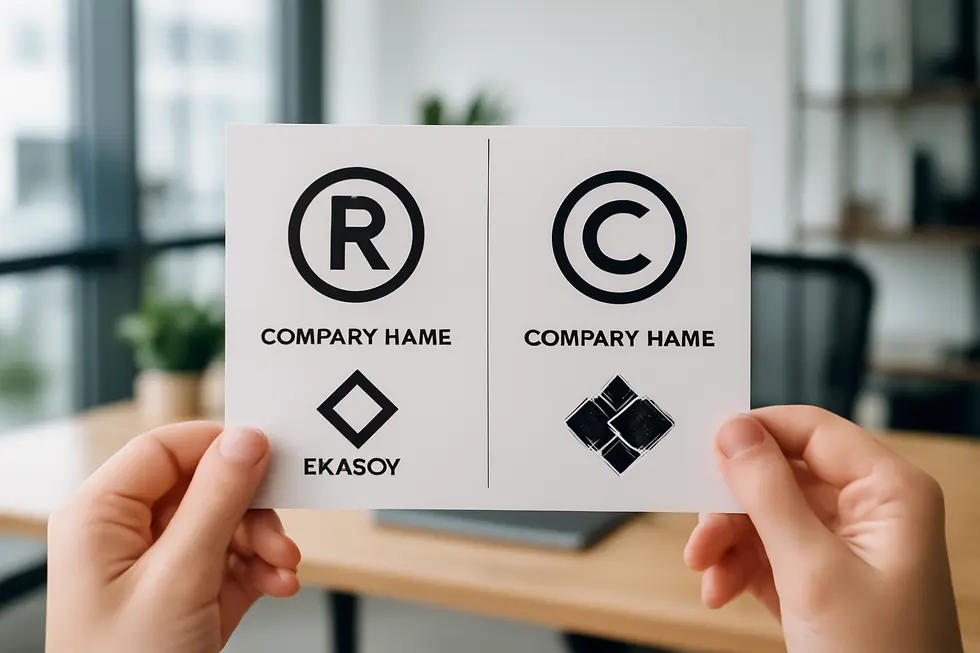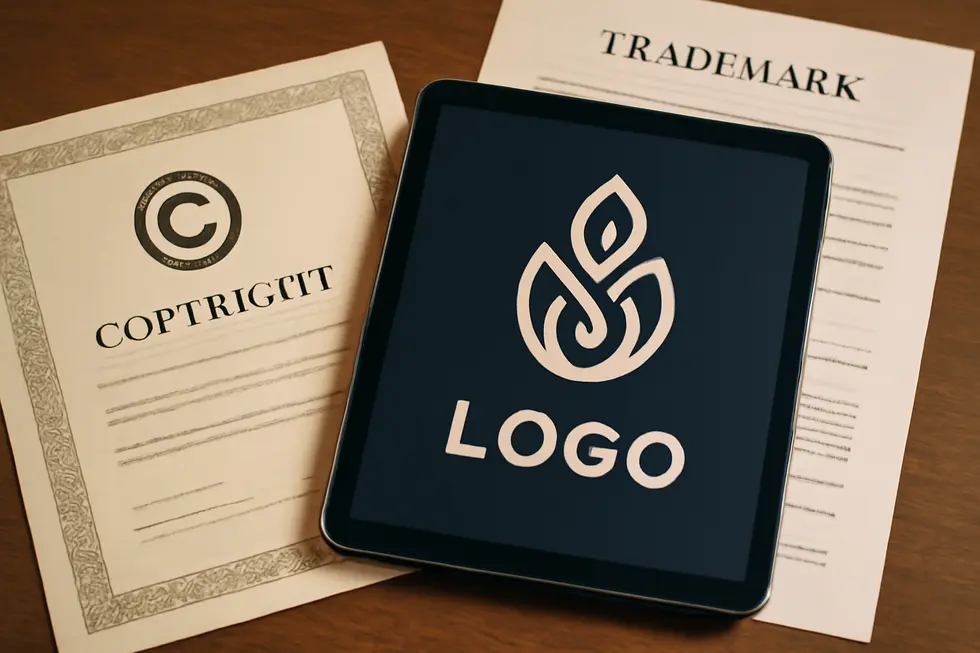Introduction
Securing legal protection for your company name and logo is vital in establishing and maintaining a distinct brand identity. Business owners must understand the difference between trademark and copyright protection to safeguard their brand’s commercial and artistic elements effectively. This guide walks you through how to copyright a company name and logo by focusing primarily on trademark registration—your strongest tool for exclusive rights in commerce. You will explore the crucial first step of conducting a comprehensive trademark search to avoid conflicts, followed by a detailed walkthrough of the USPTO trademark application process. Additionally, you’ll learn how to navigate USPTO’s review phases, respond to office actions, and maintain registration with ongoing enforcement strategies. Finally, this guide clarifies the complementary role of copyright registration for logos, emphasizing why trademark protection is essential for business owners aiming for complete brand security. With each chapter, you’ll gain actionable insights designed to empower you with the knowledge needed to protect what defines your enterprise.
Tables of Contents
Chapter 1: How to Copyright a Company Name and Logo: Understanding Trademark versus Copyright Protection
- Mastering Trademark Protection for Your Company Name and Logo
- Balancing Artistic Rights and Brand Identity: The Crucial Role of Copyright in Logo Protection
- Navigating the Trademark and Copyright Registration Journey for Company Names and Logos
Chapter 2: How to Copyright a Company Name and Logo: Conducting a Comprehensive Trademark Search
- Mastering Trademark Searches: Essential Strategies to Vet Company Names and Logos Effectively
- Navigating the Trademark Journey: From Search to Registration and Protecting Your Brand Identity
- Navigating Legal, Economic, and Societal Stakes: The Vital Role of Trademark Search in Brand Protection
Chapter 3: How to Copyright a Company Name and Logo: The Step-by-Step USPTO Trademark Application Process
- Mastering the Essential Trademark Search for Your Company Name and Logo
- Navigating the Completion and Submission of Your USPTO Trademark Application
- Navigating USPTO Communications and Confirming Trademark Registration
Chapter 4: How to Copyright a Company Name and Logo: Navigating USPTO Review and Addressing Office Actions
- Mastering Trademark Search and Application Preparation for USPTO Approval
- Effectively Overcoming USPTO Office Actions to Secure Trademark Protection for Your Company Name and Logo
- Sustaining Trademark Protection: Essential Post-Approval Actions and Legal Vigilance
Chapter 5: How to Copyright a Company Name and Logo: Registration Maintenance and Enforcement of Trademark Rights
- Navigating Trademark Registration: Securing Your Company Name and Logo for Legal Protection
- Sustaining Legal Protection: Essential Maintenance Steps for Trademarked Company Names and Logos
- Effective Strategies for Enforcing Your Trademark Rights and Preventing Infringement
Chapter 6: How to Copyright a Company Name and Logo: The Role of Copyright Registration for Logos Versus Trademark Protection
- Distinguishing Copyright and Trademark for Effective Company Name and Logo Protection
- Navigating Trademark Registration and Copyright for Company Name and Logo Protection
- The Strategic Value of Trademark Protection in Sustaining Brand Power and Market Success
Chapter 1: How to Copyright a Company Name and Logo: Understanding Trademark versus Copyright Protection

1. Mastering Trademark Protection for Your Company Name and Logo
Trademark protection is the cornerstone for securing your company name and logo. Unlike copyright, which safeguards original creative works, trademarks legally protect brand identifiers used in commerce, such as company names, logos, and slogans. Registering a trademark with the United States Patent and Trademark Office (USPTO) grants exclusive rights to use these marks, preventing competitors from adopting confusingly similar identifiers that could dilute your brand. You can choose to register the name and logo either together as a combined mark or separately to maximize flexibility and protection. Conducting a thorough trademark search beforehand is essential to avoid conflicts and rejection. Federal registration not only strengthens your legal position but also allows enforcement against infringement, preserving your brand’s commercial value. While logo artwork may receive copyright protection, trademark registration remains critical for controlling the use and distinctiveness of your company’s identity. For a deeper dive into protecting business names and logos, see trademark and business name protection.
For further guidance on combined trademarks and their advantages, consult the detailed explanation at UpCounsel on Combined Trademark Protection.
2. Balancing Artistic Rights and Brand Identity: The Crucial Role of Copyright in Logo Protection
While trademark registration is essential for securing exclusive commercial rights to a company’s logo, copyright plays a complementary role by protecting the logo’s original artistic expression. Copyright applies automatically upon the creation of a unique logo design, safeguarding visual elements such as shapes, color schemes, and creative details as intellectual property. Registering this copyright strengthens your ability to enforce these rights legally against unauthorized copying or reproduction through formal actions. However, copyright focuses strictly on the artwork itself, not the logo’s commercial significance or function as a brand identifier, which remains the domain of trademark law. Together, copyright and trademark form a layered defense: copyright secures the creative content, while trademark ensures your logo’s exclusive use in commerce, preventing confusion among consumers. Some businesses even pursue design patents for novel ornamental aspects, though this is less common. This dual strategy, supported by official registration procedures, maximizes protection over both the logo’s artistic and commercial value, a vital consideration in safeguarding your company’s brand assets. For more insights, see copyright and trademark law for business owners.
3. Navigating the Trademark and Copyright Registration Journey for Company Names and Logos
Registering a company name and logo involves distinct steps focusing primarily on trademark protection, as it covers identifiers in commerce. Begin with a comprehensive search using the USPTO’s Trademark Electronic Search System (TESS) to confirm your desired name and logo are unique. Next, determine the correct trademark class based on your goods or services and prepare a detailed application, including the exact name, logo designs, and descriptions. File the application online via the USPTO’s portal, selecting either a standard character mark or a special form mark for logos, and pay the associated fee. After submission, an examining attorney reviews the application, possibly issuing office actions requiring your response. Once cleared, the USPTO issues a registration certificate, granting rights that last ten years and are renewable. In contrast, company names cannot be copyrighted, though original logos qualify for copyright protection if registered separately with the U.S. Copyright Office, protecting the artistic expression but not commercial identity. Combining trademark registration for the name and logo with copyright registration for the logo’s creative elements ensures robust, dual-layered legal protection. This approach safeguards your brand’s identity and creative assets while minimizing infringement risks. For further insights on protecting your company’s brand identifiers, explore detailed guidance on company trademarks and logos. Comprehensive application instructions are available at the USPTO website.
Chapter 2: How to Copyright a Company Name and Logo: Conducting a Comprehensive Trademark Search

1. Mastering Trademark Searches: Essential Strategies to Vet Company Names and Logos Effectively
Conducting a thorough trademark search is the foundational step to protect your company name and logo from legal conflicts. Start by leveraging the USPTO’s Trademark Electronic Search System (TESS) to identify existing or pending trademarks in relevant categories. It’s crucial to examine variations and phonetic equivalents of your company name, alongside design code searches for logos, to catch potential similarities that could pose conflicts. Additionally, local and state trademark databases should be checked, as they may harbor unregistered yet legally significant marks. Analyzing search results requires attention to likeness in sound, appearance, and trade channels to assess infringement risks accurately. Using Boolean operators and classification systems like the internationally recognized Nice Classification enhances search precision. Emerging AI-driven tools are also valuable for detecting visual similarities in complex logos. Following this comprehensive vetting process minimizes legal risks and lays the groundwork for successful trademark registration, safeguarding your brand identity effectively. For detailed guidance on protecting business names and logos, visit trademark protection business name logo. More information is available at the USPTO TESS database: https://www.uspto.gov/trademarks/search
2. Navigating the Trademark Journey: From Search to Registration and Protecting Your Brand Identity
Trademark registration is the essential legal strategy to protect a company name and logo as brand identifiers, ensuring exclusive commercial rights and preventing others from using confusingly similar marks. It starts with a comprehensive trademark search that goes beyond the USPTO database to include state records, common law uses, domain names, and social media platforms, reducing risks of conflicts and rejection. Following this, identifying the correct trademark classification aligns the mark with specific goods or services. Submitting a precise application through the USPTO’s online system with accurate descriptions of the name, logo, and associated classes, accompanied by required fees, initiates the formal process. Applicants must then actively monitor USPTO communications, promptly addressing any Office Actions or inquiries to advance registration. After successful approval, the trademark registration grants enforceable protection, critical for defending against infringement and maintaining brand integrity over time. While logos may have some copyright protection as artistic works, trademark registration remains vital for securing exclusive rights tied to a company’s commercial identity. Engaging trademark professionals can greatly facilitate navigating these legal complexities. For further details, consult the USPTO Trademark Electronic Application System and Design Search Manual. For additional insights on protecting your brand, see this detailed guide on trademark protection for business names and logos.
3. Navigating Legal, Economic, and Societal Stakes: The Vital Role of Trademark Search in Brand Protection
Trademark registration is the cornerstone of legally protecting your company name and logo, surpassing copyright’s scope by securing exclusive commercial rights nationwide. Conducting a thorough trademark search beforehand is critical to avoid costly infringements and ensure your brand’s distinctiveness in the market. Legally, federal registration grants strong presumptive ownership, enabling you to enforce rights in experienced federal courts. Economically, trademarks shield your brand from competitors’ imitation or cybersquatting, preserving market value and enhancing consumer trust that can translate into licensing opportunities. Societally, trademarks help consumers reliably identify genuine products, fostering confidence in quality and preventing confusion caused by counterfeit goods. A comprehensive trademark search extends beyond federal databases to state registrations and common law uses, minimizing risk and maximizing your brand’s strength. This foundational step is indispensable to building a protected, recognizable identity that fuels enduring commercial success. For detailed guidance, see trademark protection for business names and logos.
Chapter 3: How to Copyright a Company Name and Logo: The Step-by-Step USPTO Trademark Application Process

1. Mastering the Essential Trademark Search for Your Company Name and Logo
Before filing a trademark application with the USPTO, conducting a comprehensive trademark search is critical to avoid conflicts and rejection. Start by using the USPTO’s Trademark Electronic Search System (TESS) to examine existing registered and pending marks. Since TESS matches exact terms, search all variations, including different spellings, abbreviations, and phonetic alternatives of your company name and logo text. For logos, employ the Trademark Design Search Code Manual to identify relevant design codes and uncover similar mark designs. Expand your efforts by reviewing state trademark databases and common law uses, as some rights may exist locally even without federal registration. Carefully determine the correct goods or services classes aligned with your business offerings to ensure accurate trademark coverage. Keeping detailed records of every search and result helps gauge risk before application. When complex situations arise, seeking expert guidance can save time and strengthen your trademark’s chance of success. This thorough search phase forms the foundation for securing exclusive rights to your company’s name and logo. For detailed instructions, visit USPTO Trademark Search Steps or explore resources on trademark protection for business names and logos.
2. Navigating the Completion and Submission of Your USPTO Trademark Application
Successfully completing and submitting your trademark application through the USPTO begins by creating an account on USPTO.gov and verifying your identity using ID.me. This authentication is essential before filing. Next, conduct a comprehensive search via the USPTO’s Trademark Electronic Search System (TESS) to confirm your company name and logo are unique and not already registered.
Prepare your application by gathering a clear representation of your logo and accurately describing your goods or services, selecting the correct trademark class per the Nice Classification. Using the Trademark Electronic Application System (TEAS), fill in all required details and upload specimens that demonstrate your mark in use commercially. Pay the applicable filing fee, which depends on the number of classes selected.
After submission, retain your confirmation and monitor your application status regularly, as the USPTO may issue office actions requiring responses. While not mandatory, consulting a trademark attorney can help reduce errors and improve your chances of approval. For visual guidance on the process, the USPTO offers a helpful video tutorial here: https://www.youtube.com/watch?v=zXDQQqGroiI.
For a deeper dive on safeguarding your brand’s identity beyond application, explore detailed insights on trademark protection for business names and logos.
3. Navigating USPTO Communications and Confirming Trademark Registration
Once you file your trademark application with the USPTO, actively monitoring its status is crucial. Use the Trademark Status and Document Retrieval (TSDR) system to track updates and promptly address any office actions. These communications may request clarifications or highlight conflicts, and timely, well-prepared responses within six months prevent application abandonment. After examination, your mark is published for opposition, allowing third parties 30 days to object. If no opposition arises or disputes are resolved, the USPTO issues your registration certificate, granting exclusive rights. Maintaining this protection requires filing renewal documents at specific intervals to keep your trademark valid. Additionally, enforcing your trademark rights against unauthorized use is vital to preserving your brand’s integrity. Securing related domain names and managing online presence further protects your identity from infringement. For a detailed step-by-step overview, visit this comprehensive tutorial: https://www.youtube.com/watch?v=zXDQQqGroiI. Learn more about trademark fundamentals at trademark protection for business name and logo.
Chapter 4: How to Copyright a Company Name and Logo: Navigating USPTO Review and Addressing Office Actions

1. Mastering Trademark Search and Application Preparation for USPTO Approval
The foundational step to securing exclusive rights for your company name and logo lies in conducting a thorough trademark search. This process involves examining all potential conflicts by checking variant spellings and design similarities through the USPTO’s Trademark Electronic Search System (TESS). For logos, understanding and using the Trademark Design Codes ensures a complete search for related designs, minimizing risk of rejection due to existing trademarks.
Once clearance is established, preparing a well-structured application is crucial. Applicants must precisely classify goods and services according to the international Nice Classification, represent the logo clearly, and choose an appropriate filing basis—whether use-based or intent-to-use. Accurate preparation significantly reduces USPTO objections during review.
Engaging professional guidance can be invaluable to navigate nuances of the application, anticipate potential objections, and respond to USPTO communications effectively. Timely, detailed responses to office actions are vital to avoid abandonment and achieve registration. This thorough approach sets the stage for smooth USPTO processing and robust brand protection.
For more detailed insights into protecting company identities through trademarks, see trademark protection for business name and logo.
Reference: https://guides.lib.uw.edu/c.php?g=341727&p=2299625
2. Effectively Overcoming USPTO Office Actions to Secure Trademark Protection for Your Company Name and Logo
When the USPTO issues an Office Action during your company name and logo trademark application, it signals concerns needing your careful response. This document details objections such as potential conflicts with existing trademarks or issues with distinctiveness. To move forward, you must thoroughly understand these objections and respond within the USPTO’s deadline—typically three months—to avoid abandonment. Your reply often requires strategic amendments to the application and clear, persuasive arguments explaining why your mark qualifies for registration. Supporting evidence like consumer surveys or sales data can strengthen your case against descriptiveness or confusion claims. Given the complexity and legal nuance, professional legal guidance is invaluable to craft a compelling response that aligns with USPTO standards. Remaining engaged during this back-and-forth is crucial, as successful navigation of Office Actions secures the federal protections essential for your brand identity. For detailed procedural insights, see the USPTO guidance on design logo patents and explore trademark protection fundamentals at trademark protection business name logo.
3. Sustaining Trademark Protection: Essential Post-Approval Actions and Legal Vigilance
Successfully registering a trademark for your company name and logo is only the start of a continuous legal journey. Once the USPTO approves your application, maintaining the trademark requires diligent attention to specific deadlines and filings. Between the 5th and 6th year after registration, you must file a Declaration of Continued Use to confirm active trademark use; neglecting this can result in cancellation. Additionally, filing a Declaration of Incontestability strengthens your mark against challenges. Renewals, combining Sections 8 and 9 filings, are due every ten years to keep protection intact. Beyond filings, actively monitoring the marketplace is critical to identify infringements early, allowing enforcement through cease-and-desist notices or litigation when necessary. Accurate documentation and timely responses to any USPTO inquiries remain vital. For businesses aiming for global reach, international trademark protections should be considered. Given the complexity of these obligations, consulting a trademark attorney can help safeguard your brand effectively and ensure compliance through every stage of maintaining your trademark rights. For deeper guidance, visit this resource on trademark protection for business names and logos.
Chapter 5: How to Copyright a Company Name and Logo: Registration Maintenance and Enforcement of Trademark Rights

1. Navigating Trademark Registration: Securing Your Company Name and Logo for Legal Protection
Protecting a company name and logo primarily involves registering them as trademarks rather than relying on copyright. Trademark registration grants exclusive legal rights to use your brand identifiers nationwide, preventing others from using similar marks that could confuse consumers. The process begins with a thorough trademark search using official databases, like the USPTO’s Trademark Electronic Search System, to ensure your mark is unique and not already in use. Next, a detailed application must describe the company name and logo fully, including colors and design elements, along with the classification of goods or services under the Nice Classification system. Filing the application with the trademark office involves paying fees, submitting supporting documents, and then waiting for examination. The office may issue requests for clarification or objections, and if cleared, your mark is published for opposition before registration is granted. Registered trademarks remain valid for ten years and can be renewed indefinitely, providing critical, ongoing brand protection. Early registration is essential to establish priority and avoid infringement disputes. For further insights, see this detailed trademark registration guide. For comprehensive assistance, businesses often consult legal experts to streamline this vital process. For more information on trademark versus copyright, visit trademark protection for business names and logos.
2. Sustaining Legal Protection: Essential Maintenance Steps for Trademarked Company Names and Logos
Securing trademark registration for your company name and logo is just the start of protecting your brand’s identity. To maintain these rights, the trademark holder must actively manage filings and demonstrate ongoing commercial use. Between the 5th and 6th year after registration, filing a Declaration of Continued Use with the USPTO verifies that your trademark remains in active commerce. Failure to file this declaration can result in cancellation. Additionally, every decade the trademark must be renewed through a formal renewal application to extend legal protection for another ten years.
Continuous use of the trademark is critical; abandonment or non-use for three years can lead to loss of rights. Vigilantly monitoring the marketplace and trademark databases helps prevent infringement or unauthorized use that could dilute your brand. While logos receive automatic copyright protection, trademark registration uniquely safeguards the commercial identity, providing the strongest enforceable rights nationwide. For effective guidance on protecting business names and logos, consulting resources on trademark protection for business name and logo is highly recommended.
Maintaining trademark rights demands consistent attention to renewal deadlines and active use to preserve the exclusive legal benefits that safeguard your company’s reputation and assets.
3. Effective Strategies for Enforcing Your Trademark Rights and Preventing Infringement
Securing trademark registration gives your company name and logo exclusive legal protections, but enforcement is key to preserving those rights. Continuous brand monitoring is essential; leveraging online tools and trademark watch services helps detect unauthorized use early. Building a defensive portfolio by registering variations and spellings broadens your protective scope and discourages similar marks. When infringement occurs, sending cease-and-desist letters is often the first step, demanding the infringer stop unauthorized use. If ignored, escalating to litigation is necessary to uphold your rights and seek damages. Prioritizing threats based on their market impact and brand harm ensures efficient use of resources. Unlike copyright, which protects logo artwork’s artistic expression, trademark enforcement safeguards the commercial identity of your company name and logo. For comprehensive guidance through enforcement complexities, consulting a trademark attorney is advisable. For further insights on protecting your company’s brand identity, review this detailed resource on trademark protection, business name, and logo.
More details on application and enforcement procedures can be found at the official USPTO site: https://www.uspto.gov/trademarks.
Chapter 6: How to Copyright a Company Name and Logo: The Role of Copyright Registration for Logos Versus Trademark Protection

1. Distinguishing Copyright and Trademark for Effective Company Name and Logo Protection
Distinguishing Copyright and Trademark for Effective Company Name and Logo Protection
Protecting a company name and logo involves understanding the distinct roles of copyright and trademark law. While copyright protection for logos is automatic upon creation, covering the artistic aspects, it does not extend to commercial use or brand identity. Trademark registration, however, is essential to secure exclusive rights to a company name and logo as identifiers of goods or services in commerce. This grants legal authority to prevent others from using similar marks that could cause confusion. Trademark protection requires formal registration with the USPTO, a process that includes conducting a thorough search, submitting detailed applications, and maintaining registration through continued use. Copyright registration can supplement this protection by strengthening the legal remedies available for unauthorized copying of the logo’s creative design. Together, these protections safeguard both the visual creativity and the commercial value of your brand. For practical guidance on securing trademark rights, see trademark protection for business name and logo.
External source: https://www.wix.com/blog/how-to-design-a-logo
2. Navigating Trademark Registration and Copyright for Company Name and Logo Protection
To secure exclusive commercial rights over a company name and logo, trademark registration is the essential legal tool, unlike copyright which protects only artistic creativity. The trademark process begins with a comprehensive search in the USPTO database to confirm your mark’s uniqueness. Next, you file a detailed application online, specifying your company name, a clear logo image, and the categories of goods or services it will cover under the Nice Classification system. Following submission, the USPTO examines your application and may raise objections requiring your response. If approved, your mark is published for opposition before full registration and issuance of a certificate granting exclusive use rights for ten years, renewable indefinitely. While logos may receive automatic copyright protection as original artwork, copyright does not prevent others from using similar marks as brand identifiers. Therefore, combining trademark registration with optional copyright registration offers both commercial brand security and artistic protection. For further guidance, exploring trademark registration for business name and logo provides valuable insights. Additional detailed procedural information is available through resources such as taxlegit.com/trademark-registration.
3. The Strategic Value of Trademark Protection in Sustaining Brand Power and Market Success
Trademark protection serves as a cornerstone for securing a company’s name and logo, supporting enduring brand influence and economic growth. By granting exclusive commercial rights, trademarks prevent misuse and brand dilution, maintaining consumer confidence and competitive positioning. This legal safeguard translates into measurable economic benefits such as increased brand equity, which in turn boosts customer loyalty and enterprise valuation. Moreover, businesses leveraging strong trademarks attract investments and can generate licensing revenues, fueling expansion opportunities both domestically and globally. Beyond economics, trademarks promote societal benefits by protecting consumers from confusion and ensuring fair competition, which encourages innovation and diversity in the marketplace. Strategically, securing federal trademark registration, potentially for both company names and logos separately, offers robust and flexible defense suited to evolving branding needs. Conducting comprehensive intellectual property audits ensures all valuable assets are protected, solidifying a brand’s foundation. This protective framework not only fosters business longevity but also strengthens market presence and consumer trust, highlighting why trademark registration is essential in the broader context of copyright and brand identity. For detailed insights on combined trademark strategies, visit UpCounsel’s guide on combined trademarks.
Final thoughts
Effectively protecting your company name and logo requires a clear understanding of both trademark and copyright protections and their distinct roles. Trademark registration through the USPTO stands as the primary legal safeguard securing your brand identity and exclusive commercial rights. Initiating protection with a thorough trademark search, successfully navigating application and review processes, and maintaining enforcement are critical steps in this journey. While copyright registration plays a supportive role by securing the artistic integrity of your logo, it cannot replace the broad, commercial protections a trademark affords. Armed with this knowledge, business owners can confidently take the necessary legal steps to fortify their brands, ensuring their unique company name and logo remain powerful assets in the marketplace for years to come.
Your IP is the foundation of your success – let’s protect it together before it’s too late. We can’t wait to help you turn your ideas into legally secured assets.
About us
undefined


